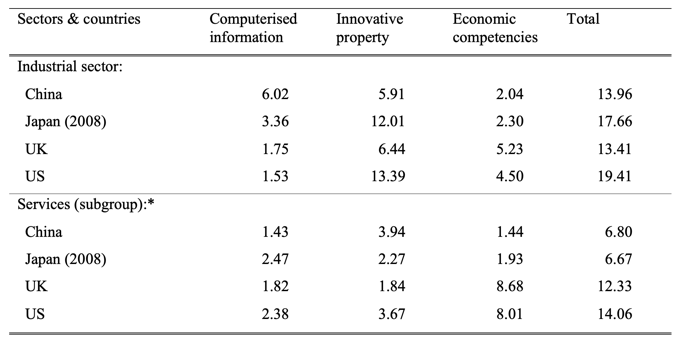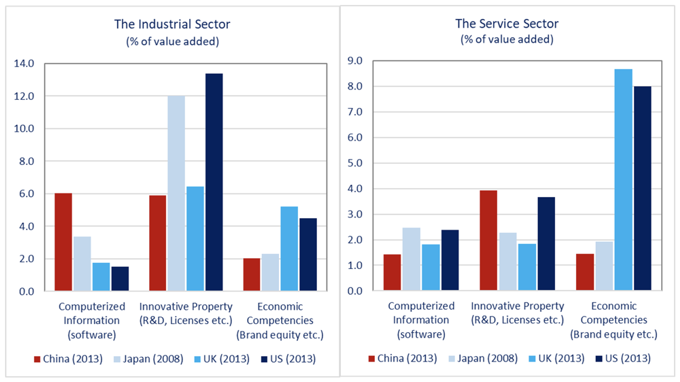China expects its service sector to play an important role in helping the economy restructure. This column measures China’s investment in intangibles as a good indicator of an economy’s future creativity. China’s services sector does not invest sufficiently in intangibles. The Chinese wholesale and retail sector, for example, spends only 1.21% of its value added on intangible assets, compared to 5.7% in the US. Chinese wholesale and retail services would have to invest heavily in building strong brands to catch up with their US counterparts.
Investment in intangible capital assets, such as software, R&D, and brand equity, is a good indicator of the potential power of an economy’s future creativity. As explained in Corrado et al. (2005), intangible assets are knowledge-intensive and complementary to information and communication technologies (ICT) and ICT-enhanced hardware investment, including software, design, market research, R&D, training, and business processes. They cannot be physically touched or seen but are critical to reaping ICT’s productivity advantages. They thus are the key assets of today’s knowledge-intensive economy.
When examining slow productivity growth in EU countries, van Ark (2004) hypothesised that the productivity gap between the EU and the US could be attributed to the lack of intangible assets that are complementary to ICT capital services. Motivated by van Ark’s hypothesis, Fukao et al. (2009) further argued that it was the intangible-assets-sensitive services that caused the productivity gap between Japan and the US.
China’s productivity slowdown and intangibles
The first-ever measure of China’s aggregate investment in intangible assets was pioneered by Hulten and Hao (2012). Having observed China’s acceleration in spending on patents, engineering and architecture designs, R&D, and exports of ICT products, they conjectured that intangible capital formation must have played an important role in China’s transition to a market-oriented economy because “the privatisation of many state-owned enterprises requires an investment in new organisational capabilities and business models, as does progress along the global value chain to a more knowledge-intensive economy”.
However, China’s growth substantially slowed down, from its 14.2% peak in 2007 to 6.2% in 2019 by the official account that has long been criticised for upward biases and, more strikingly, the country lost total factor productivity by about 1% per annum over the decade since the global financial crisis. These indicate that China is facing a grave challenge in shifting to a productivity-led growth model (Wu 2019). While appraising the productivity performance of the ICT-making and intensive-using industries in manufacturing, Wu and Liang (2017) show that the productivity growth of ICT-using services was negative for most of the period in question.
After 40 years of rapid growth, China has arrived at a crucial stage in which only productivity improvement can overcome the rise in labour costs. China’s performance in intangible investment may help explain the country’s slow productivity growth despite reforms and the potential for innovation in the government-engineered technological advancement.
Methodology and source data
In our study (Hao and Wu 2021), we follow the theory developed in Corrado et al. (2005) to coherently measure China’s investment in intangibles in an expanded sources-of-growth framework that essentially adopts Hulten’s 1979 intertemporal choice model on growth accounting. Unlike Corrado et al., we propose an approach that decomposes the aggregate estimation of intangible investment to the industry level. This is necessary because studies on the UK, Germany, Japan, and Korea show significant differences across industries (Dal Borgo et al. 2011, Hyunbae et al. 2012, Miyagawa et al. 2013, Crass et al. 2014), which suggest that homogeneous treatment of industries in terms of intangible investments is inappropriate.
This work benefits from two previous studies: the first-ever endeavour made by Hulten and Hao (2012) that provides a measurement of China’s aggregate intangible investment as a proper ‘control total’ for the intangibles of individual industries, and the first KLEMS-type China Industrial Productivity Database (CIP 3.0), developed by Wu and his associates (see Wu 2020, and a brief introduction in the data section of Hao and Wu 2021), which provides industry-level investment series in tangible assets and allows industry-specific relationships between tangible and intangible investments to be gauged.
In terms of source data, we rely on sources explored and used in Hulten and Hao (2012), extended and updated. However, while Hulten and Hao focus mainly on how to construct a proper measure of each type of intangible asset for the aggregate economy, we aim to estimate intangible assets at the industry level by breaking down Hulten and Hao’s total and, where possible, improve the data with newly available information.
Findings and implications
We focus on our results on China’s industrial sector and the service sector (the service industries were selected to reduce international incompatibility), as shown in the following table and figure. In 2013, China’s industrial sector accounted for 37% of total value added, 30% of total tangible investment (excluding investment in dwellings), and 21% of total employment in the economy. This is the sector that the government plans to upgrade in ‘Made in China 2025’, in which technological upgrading and innovation are at the core. Our estimates for intangible investment can help us evaluate the commitment of the industrial sector to the call of the government.


[Click to enlarge]
In 2013, China’s industrial sector invested 14% of its value added in intangible assets, committing substantial resources to build innovation capacity and move up the global value chain. The Chinese level of intangible investment is similar to or even slightly higher than that of the UK and about 70% of the US in the industrial sector for the same year, and about 80% of that of Japan in 2008.
However, compared to other economies, the Chinese investment is strongly skewed towards computerised information, narrowly defined as software, and as a co-investment with equipment and possibly driven by investment in ICT equipment. This implies that although China’s industrial sector may have upgraded its ICT-related equipment, it may not have accumulated enough technological innovation, brand equity, human capital, and modern organisation structures to compete with its peers in advanced economies.
The Chinese government saw that the industrial sector suffers from surplus capacity, slowing productivity growth and rising labour cost. It thus expects the service sector to play an important role in helping the economy restructure and move up quickly in the global value chain. When the GDP share of the service sector surpassed that of the industrial sector in 2014, the National Bureau of Statistics said that the service sector had become a new growth driver of the economy. The 13th Five-Year Plan (2016–2020) states that the government plans to make the service sector of higher quality.
However, China’s services sector does not commit much of its resources toward that purpose. In 2013, China’s intangible investment in all services was merely about half of that in the UK and the US, but similar to that of Japan in 2008.
Investment in brand equity of the wholesale and retail sector is a case in point. Brand equity helps service-sector companies move up the value chain because good branding allows premium pricing. This transforms the competition among companies from competition based on low prices (thus low costs) to competition based on high quality and product differentiation. In addition, brand equity facilitates product innovation in that new products from a well-known brand are more likely to be welcomed by the market at launch.
We show that the US wholesale and retail sector spends 5.7% of its value added on five types of intangible assets (listed as adjusted intangible investment), while the Chinese wholesale and retail sector spends only 1.21%. The gap is mostly from investment in brand equity (5.1% of value added in the US versus 0.2% in China). Chinese wholesale and retail services would have to invest heavily in building strong brands to catch up with their US counterparts.
Caveat
Our biggest caveat is that about half of the intangible investment is in software, which is largely linked to investment in machines and equipment and strongly influenced by the growth race between local governments in China. We nonetheless have no choice but to keep the spending on software in our estimation, while asking researchers to bear in mind that over-investment in the Chinese industrial sector was a serious problem. This means that if more information becomes available, the software investment may need to be seriously discounted due to wasteful over-investment and misallocation of resources.
Editor’s note: The main research on which this column is based (Hao and Wu 2021) first appeared as a Discussion Paper of the Research Institute of Economy, Trade and Industry (RIETI) of Japan.
This article first appeared on www.VoxEU.org on April 17, 2022. Reproduced with permission.



